Analysis of Emerging Markets in India: A Business Report
VerifiedAdded on 2019/12/28
|10
|3255
|228
Report
AI Summary
This business report provides a comprehensive analysis of emerging markets in India. It begins with an introduction defining emerging markets and highlighting India's position. The report then delves into the characteristics of these markets, including high growth rates, risk, rapid development, political significance, volatility, and large market potential. Key opportunities in sectors like infrastructure, vocational skills, energy efficiency, healthcare, and foreign investment are explored, emphasizing the pharmaceutical market. The report also addresses challenges such as market access, pricing, and regulatory issues. The analysis highlights India's role in global markets and the importance of understanding its complex market dynamics for businesses. The report concludes by summarizing the key findings and implications for businesses operating or considering entering the Indian market.
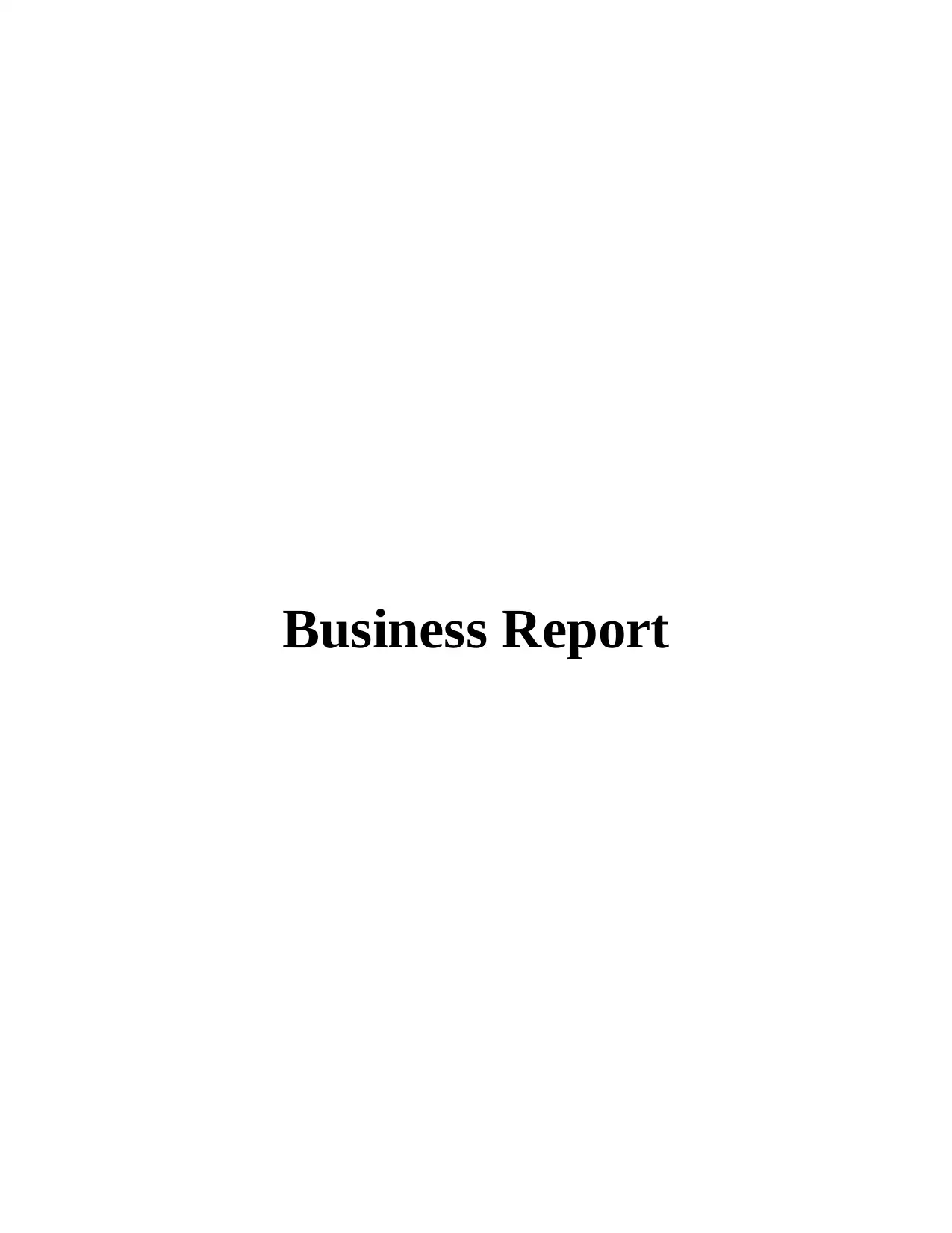
Business Report
Paraphrase This Document
Need a fresh take? Get an instant paraphrase of this document with our AI Paraphraser
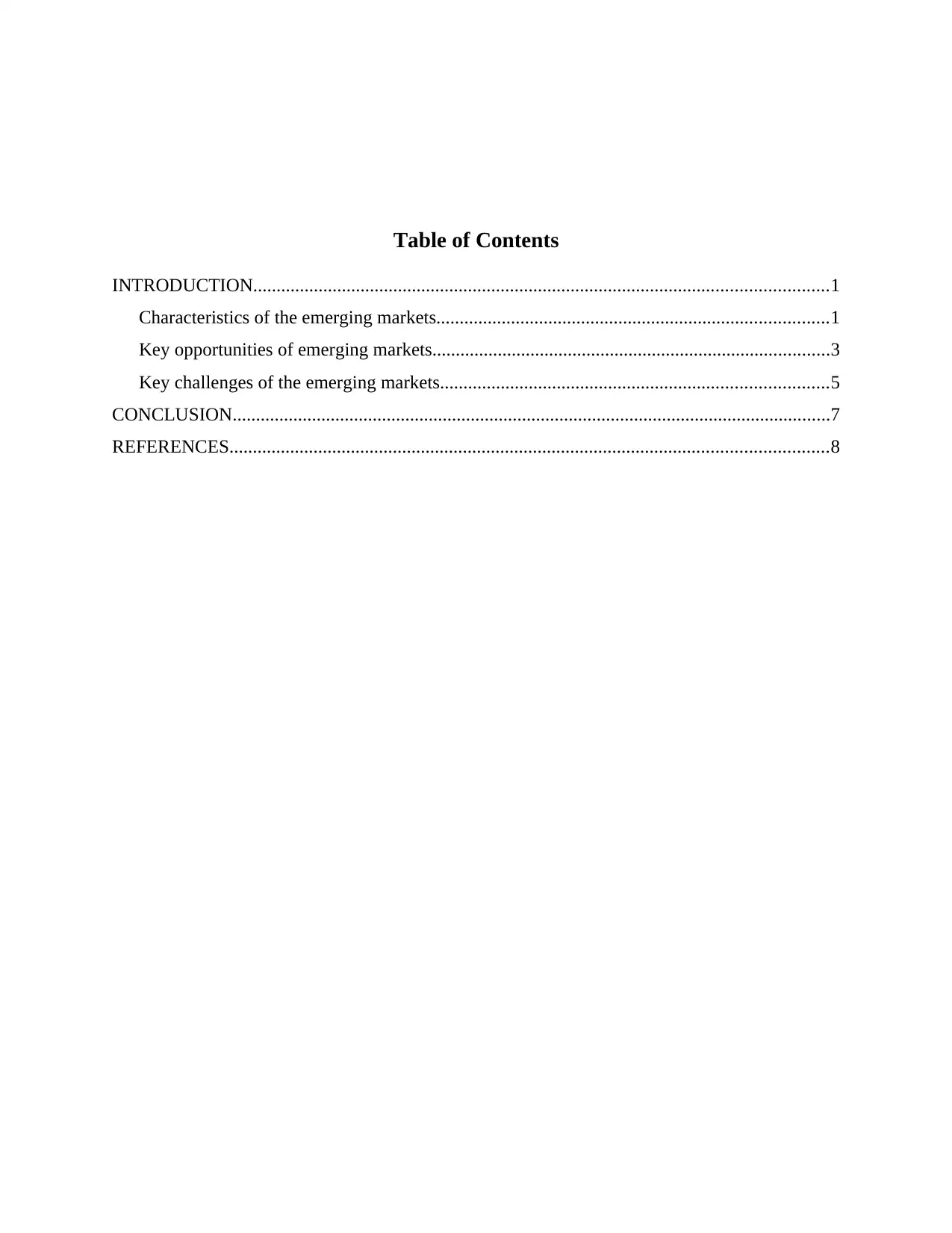
Table of Contents
INTRODUCTION...........................................................................................................................1
Characteristics of the emerging markets....................................................................................1
Key opportunities of emerging markets.....................................................................................3
Key challenges of the emerging markets...................................................................................5
CONCLUSION................................................................................................................................7
REFERENCES................................................................................................................................8
INTRODUCTION...........................................................................................................................1
Characteristics of the emerging markets....................................................................................1
Key opportunities of emerging markets.....................................................................................3
Key challenges of the emerging markets...................................................................................5
CONCLUSION................................................................................................................................7
REFERENCES................................................................................................................................8
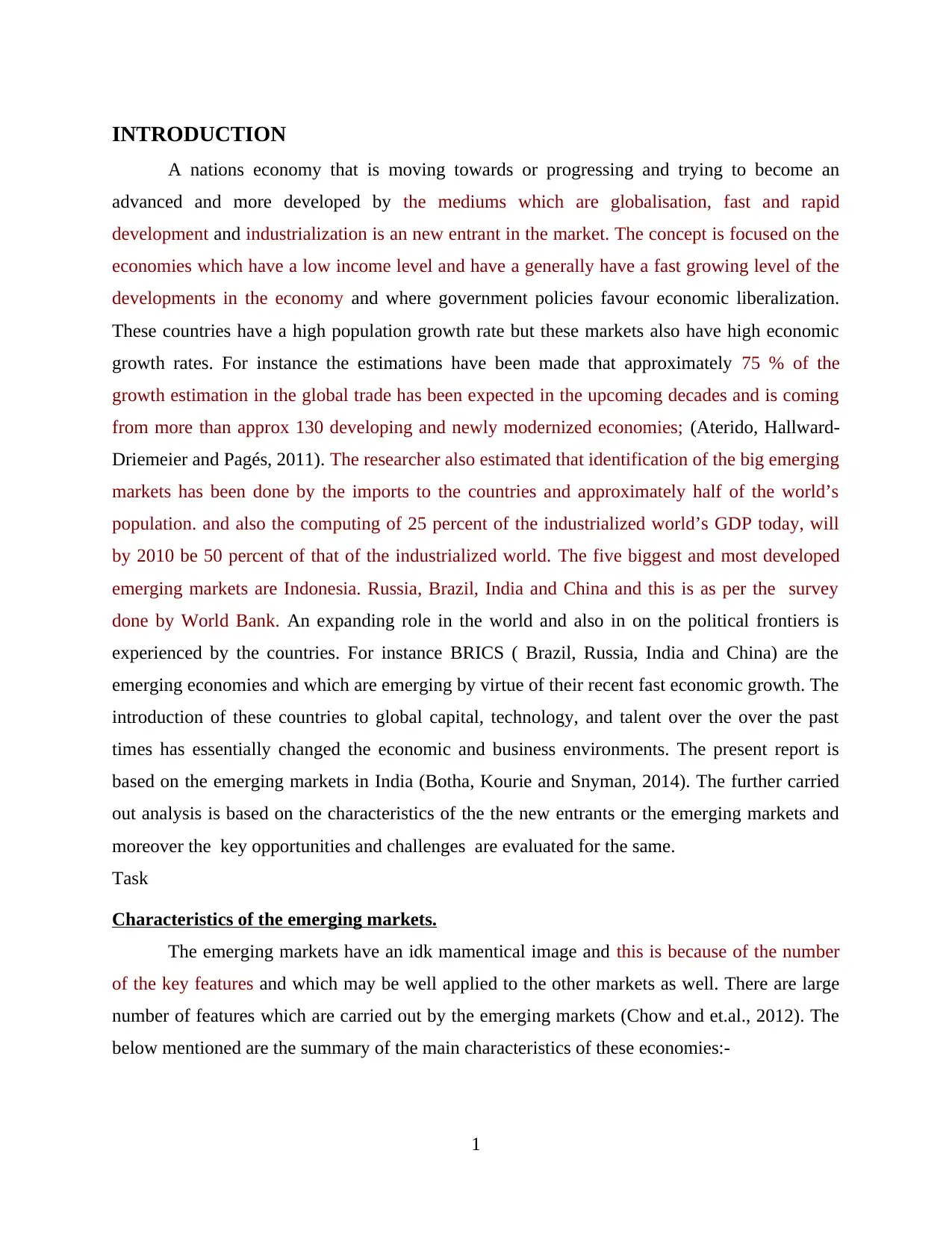
INTRODUCTION
A nations economy that is moving towards or progressing and trying to become an
advanced and more developed by the mediums which are globalisation, fast and rapid
development and industrialization is an new entrant in the market. The concept is focused on the
economies which have a low income level and have a generally have a fast growing level of the
developments in the economy and where government policies favour economic liberalization.
These countries have a high population growth rate but these markets also have high economic
growth rates. For instance the estimations have been made that approximately 75 % of the
growth estimation in the global trade has been expected in the upcoming decades and is coming
from more than approx 130 developing and newly modernized economies; (Aterido, Hallward-
Driemeier and Pagés, 2011). The researcher also estimated that identification of the big emerging
markets has been done by the imports to the countries and approximately half of the world’s
population. and also the computing of 25 percent of the industrialized world’s GDP today, will
by 2010 be 50 percent of that of the industrialized world. The five biggest and most developed
emerging markets are Indonesia. Russia, Brazil, India and China and this is as per the survey
done by World Bank. An expanding role in the world and also in on the political frontiers is
experienced by the countries. For instance BRICS ( Brazil, Russia, India and China) are the
emerging economies and which are emerging by virtue of their recent fast economic growth. The
introduction of these countries to global capital, technology, and talent over the over the past
times has essentially changed the economic and business environments. The present report is
based on the emerging markets in India (Botha, Kourie and Snyman, 2014). The further carried
out analysis is based on the characteristics of the the new entrants or the emerging markets and
moreover the key opportunities and challenges are evaluated for the same.
Task
Characteristics of the emerging markets.
The emerging markets have an idk mamentical image and this is because of the number
of the key features and which may be well applied to the other markets as well. There are large
number of features which are carried out by the emerging markets (Chow and et.al., 2012). The
below mentioned are the summary of the main characteristics of these economies:-
1
A nations economy that is moving towards or progressing and trying to become an
advanced and more developed by the mediums which are globalisation, fast and rapid
development and industrialization is an new entrant in the market. The concept is focused on the
economies which have a low income level and have a generally have a fast growing level of the
developments in the economy and where government policies favour economic liberalization.
These countries have a high population growth rate but these markets also have high economic
growth rates. For instance the estimations have been made that approximately 75 % of the
growth estimation in the global trade has been expected in the upcoming decades and is coming
from more than approx 130 developing and newly modernized economies; (Aterido, Hallward-
Driemeier and Pagés, 2011). The researcher also estimated that identification of the big emerging
markets has been done by the imports to the countries and approximately half of the world’s
population. and also the computing of 25 percent of the industrialized world’s GDP today, will
by 2010 be 50 percent of that of the industrialized world. The five biggest and most developed
emerging markets are Indonesia. Russia, Brazil, India and China and this is as per the survey
done by World Bank. An expanding role in the world and also in on the political frontiers is
experienced by the countries. For instance BRICS ( Brazil, Russia, India and China) are the
emerging economies and which are emerging by virtue of their recent fast economic growth. The
introduction of these countries to global capital, technology, and talent over the over the past
times has essentially changed the economic and business environments. The present report is
based on the emerging markets in India (Botha, Kourie and Snyman, 2014). The further carried
out analysis is based on the characteristics of the the new entrants or the emerging markets and
moreover the key opportunities and challenges are evaluated for the same.
Task
Characteristics of the emerging markets.
The emerging markets have an idk mamentical image and this is because of the number
of the key features and which may be well applied to the other markets as well. There are large
number of features which are carried out by the emerging markets (Chow and et.al., 2012). The
below mentioned are the summary of the main characteristics of these economies:-
1
⊘ This is a preview!⊘
Do you want full access?
Subscribe today to unlock all pages.

Trusted by 1+ million students worldwide
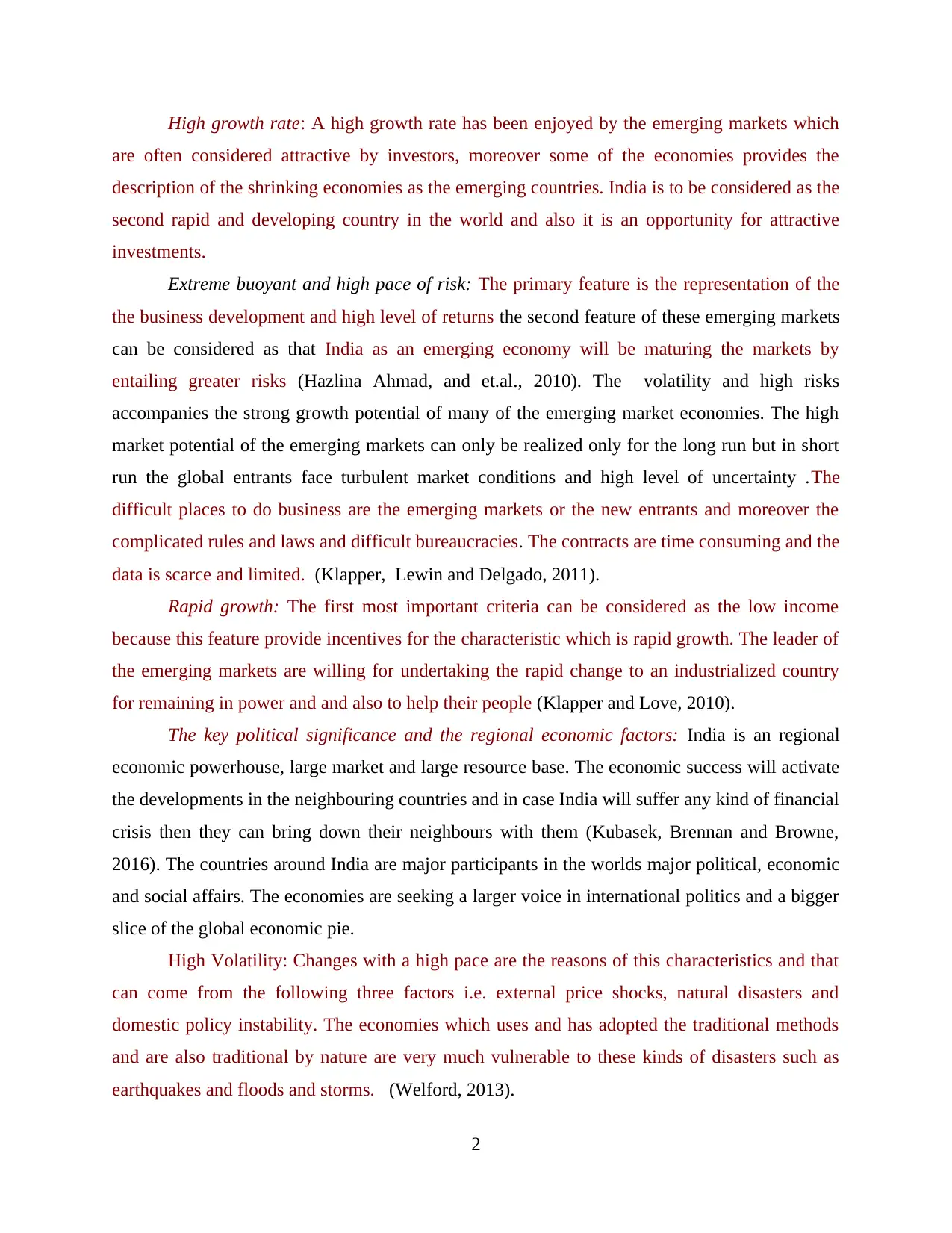
High growth rate: A high growth rate has been enjoyed by the emerging markets which
are often considered attractive by investors, moreover some of the economies provides the
description of the shrinking economies as the emerging countries. India is to be considered as the
second rapid and developing country in the world and also it is an opportunity for attractive
investments.
Extreme buoyant and high pace of risk: The primary feature is the representation of the
the business development and high level of returns the second feature of these emerging markets
can be considered as that India as an emerging economy will be maturing the markets by
entailing greater risks (Hazlina Ahmad, and et.al., 2010). The volatility and high risks
accompanies the strong growth potential of many of the emerging market economies. The high
market potential of the emerging markets can only be realized only for the long run but in short
run the global entrants face turbulent market conditions and high level of uncertainty .The
difficult places to do business are the emerging markets or the new entrants and moreover the
complicated rules and laws and difficult bureaucracies. The contracts are time consuming and the
data is scarce and limited. (Klapper, Lewin and Delgado, 2011).
Rapid growth: The first most important criteria can be considered as the low income
because this feature provide incentives for the characteristic which is rapid growth. The leader of
the emerging markets are willing for undertaking the rapid change to an industrialized country
for remaining in power and and also to help their people (Klapper and Love, 2010).
The key political significance and the regional economic factors: India is an regional
economic powerhouse, large market and large resource base. The economic success will activate
the developments in the neighbouring countries and in case India will suffer any kind of financial
crisis then they can bring down their neighbours with them (Kubasek, Brennan and Browne,
2016). The countries around India are major participants in the worlds major political, economic
and social affairs. The economies are seeking a larger voice in international politics and a bigger
slice of the global economic pie.
High Volatility: Changes with a high pace are the reasons of this characteristics and that
can come from the following three factors i.e. external price shocks, natural disasters and
domestic policy instability. The economies which uses and has adopted the traditional methods
and are also traditional by nature are very much vulnerable to these kinds of disasters such as
earthquakes and floods and storms. (Welford, 2013).
2
are often considered attractive by investors, moreover some of the economies provides the
description of the shrinking economies as the emerging countries. India is to be considered as the
second rapid and developing country in the world and also it is an opportunity for attractive
investments.
Extreme buoyant and high pace of risk: The primary feature is the representation of the
the business development and high level of returns the second feature of these emerging markets
can be considered as that India as an emerging economy will be maturing the markets by
entailing greater risks (Hazlina Ahmad, and et.al., 2010). The volatility and high risks
accompanies the strong growth potential of many of the emerging market economies. The high
market potential of the emerging markets can only be realized only for the long run but in short
run the global entrants face turbulent market conditions and high level of uncertainty .The
difficult places to do business are the emerging markets or the new entrants and moreover the
complicated rules and laws and difficult bureaucracies. The contracts are time consuming and the
data is scarce and limited. (Klapper, Lewin and Delgado, 2011).
Rapid growth: The first most important criteria can be considered as the low income
because this feature provide incentives for the characteristic which is rapid growth. The leader of
the emerging markets are willing for undertaking the rapid change to an industrialized country
for remaining in power and and also to help their people (Klapper and Love, 2010).
The key political significance and the regional economic factors: India is an regional
economic powerhouse, large market and large resource base. The economic success will activate
the developments in the neighbouring countries and in case India will suffer any kind of financial
crisis then they can bring down their neighbours with them (Kubasek, Brennan and Browne,
2016). The countries around India are major participants in the worlds major political, economic
and social affairs. The economies are seeking a larger voice in international politics and a bigger
slice of the global economic pie.
High Volatility: Changes with a high pace are the reasons of this characteristics and that
can come from the following three factors i.e. external price shocks, natural disasters and
domestic policy instability. The economies which uses and has adopted the traditional methods
and are also traditional by nature are very much vulnerable to these kinds of disasters such as
earthquakes and floods and storms. (Welford, 2013).
2
Paraphrase This Document
Need a fresh take? Get an instant paraphrase of this document with our AI Paraphraser
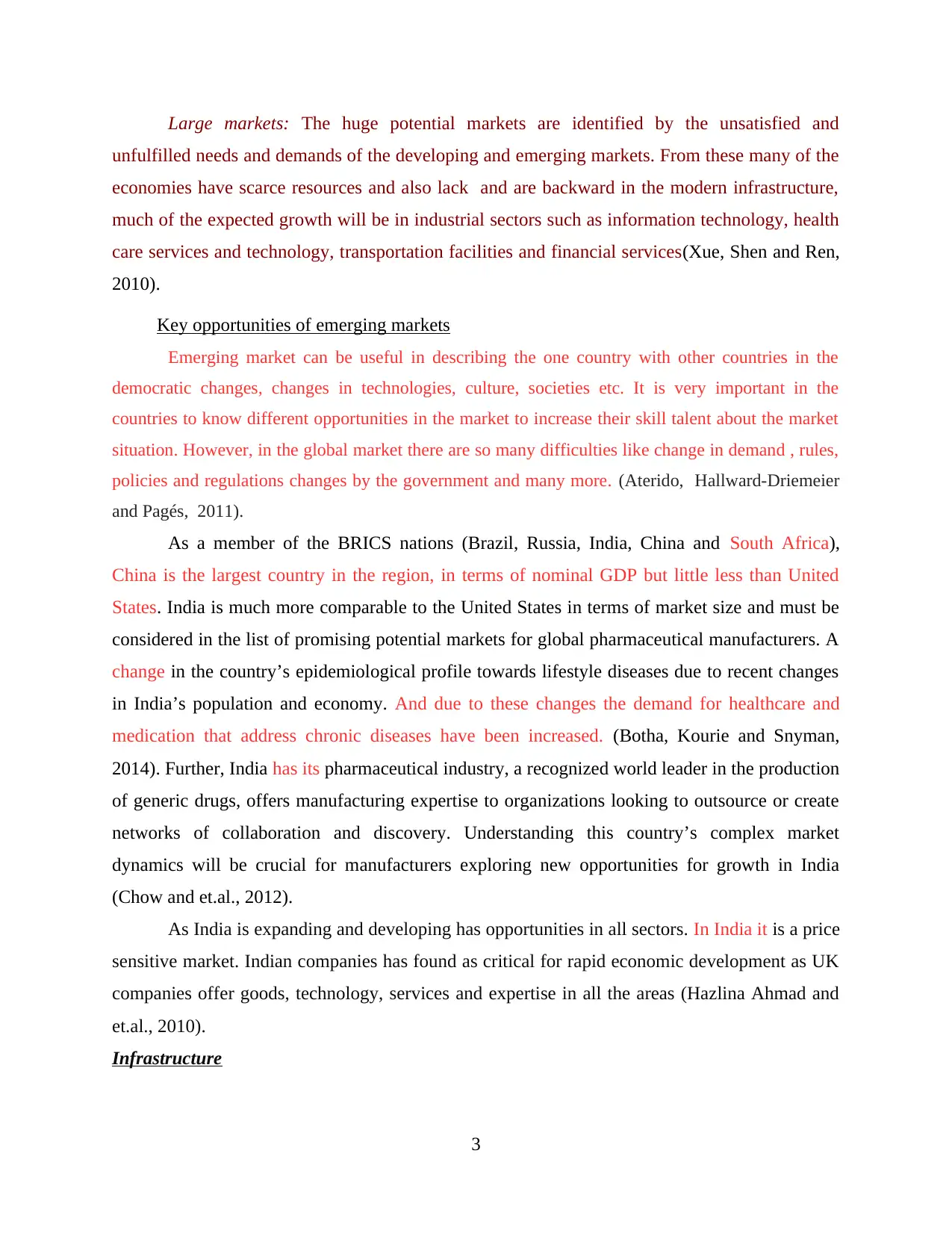
Large markets: The huge potential markets are identified by the unsatisfied and
unfulfilled needs and demands of the developing and emerging markets. From these many of the
economies have scarce resources and also lack and are backward in the modern infrastructure,
much of the expected growth will be in industrial sectors such as information technology, health
care services and technology, transportation facilities and financial services(Xue, Shen and Ren,
2010).
Key opportunities of emerging markets
Emerging market can be useful in describing the one country with other countries in the
democratic changes, changes in technologies, culture, societies etc. It is very important in the
countries to know different opportunities in the market to increase their skill talent about the market
situation. However, in the global market there are so many difficulties like change in demand , rules,
policies and regulations changes by the government and many more. (Aterido, Hallward-Driemeier
and Pagés, 2011).
As a member of the BRICS nations (Brazil, Russia, India, China and South Africa),
China is the largest country in the region, in terms of nominal GDP but little less than United
States. India is much more comparable to the United States in terms of market size and must be
considered in the list of promising potential markets for global pharmaceutical manufacturers. A
change in the country’s epidemiological profile towards lifestyle diseases due to recent changes
in India’s population and economy. And due to these changes the demand for healthcare and
medication that address chronic diseases have been increased. (Botha, Kourie and Snyman,
2014). Further, India has its pharmaceutical industry, a recognized world leader in the production
of generic drugs, offers manufacturing expertise to organizations looking to outsource or create
networks of collaboration and discovery. Understanding this country’s complex market
dynamics will be crucial for manufacturers exploring new opportunities for growth in India
(Chow and et.al., 2012).
As India is expanding and developing has opportunities in all sectors. In India it is a price
sensitive market. Indian companies has found as critical for rapid economic development as UK
companies offer goods, technology, services and expertise in all the areas (Hazlina Ahmad and
et.al., 2010).
Infrastructure
3
unfulfilled needs and demands of the developing and emerging markets. From these many of the
economies have scarce resources and also lack and are backward in the modern infrastructure,
much of the expected growth will be in industrial sectors such as information technology, health
care services and technology, transportation facilities and financial services(Xue, Shen and Ren,
2010).
Key opportunities of emerging markets
Emerging market can be useful in describing the one country with other countries in the
democratic changes, changes in technologies, culture, societies etc. It is very important in the
countries to know different opportunities in the market to increase their skill talent about the market
situation. However, in the global market there are so many difficulties like change in demand , rules,
policies and regulations changes by the government and many more. (Aterido, Hallward-Driemeier
and Pagés, 2011).
As a member of the BRICS nations (Brazil, Russia, India, China and South Africa),
China is the largest country in the region, in terms of nominal GDP but little less than United
States. India is much more comparable to the United States in terms of market size and must be
considered in the list of promising potential markets for global pharmaceutical manufacturers. A
change in the country’s epidemiological profile towards lifestyle diseases due to recent changes
in India’s population and economy. And due to these changes the demand for healthcare and
medication that address chronic diseases have been increased. (Botha, Kourie and Snyman,
2014). Further, India has its pharmaceutical industry, a recognized world leader in the production
of generic drugs, offers manufacturing expertise to organizations looking to outsource or create
networks of collaboration and discovery. Understanding this country’s complex market
dynamics will be crucial for manufacturers exploring new opportunities for growth in India
(Chow and et.al., 2012).
As India is expanding and developing has opportunities in all sectors. In India it is a price
sensitive market. Indian companies has found as critical for rapid economic development as UK
companies offer goods, technology, services and expertise in all the areas (Hazlina Ahmad and
et.al., 2010).
Infrastructure
3
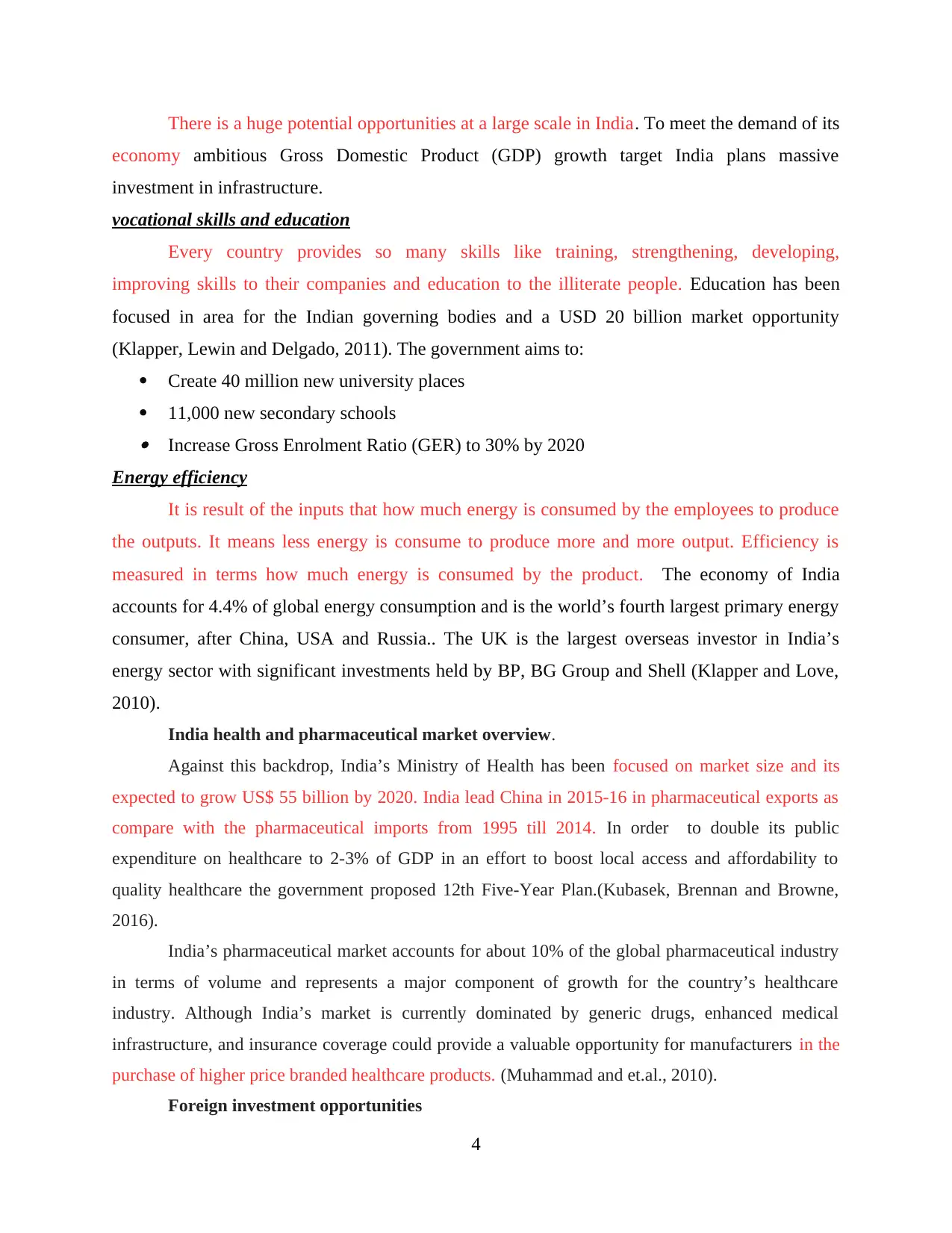
There is a huge potential opportunities at a large scale in India. To meet the demand of its
economy ambitious Gross Domestic Product (GDP) growth target India plans massive
investment in infrastructure.
vocational skills and education
Every country provides so many skills like training, strengthening, developing,
improving skills to their companies and education to the illiterate people. Education has been
focused in area for the Indian governing bodies and a USD 20 billion market opportunity
(Klapper, Lewin and Delgado, 2011). The government aims to:
Create 40 million new university places
11,000 new secondary schools Increase Gross Enrolment Ratio (GER) to 30% by 2020
Energy efficiency
It is result of the inputs that how much energy is consumed by the employees to produce
the outputs. It means less energy is consume to produce more and more output. Efficiency is
measured in terms how much energy is consumed by the product. The economy of India
accounts for 4.4% of global energy consumption and is the world’s fourth largest primary energy
consumer, after China, USA and Russia.. The UK is the largest overseas investor in India’s
energy sector with significant investments held by BP, BG Group and Shell (Klapper and Love,
2010).
India health and pharmaceutical market overview.
Against this backdrop, India’s Ministry of Health has been focused on market size and its
expected to grow US$ 55 billion by 2020. India lead China in 2015-16 in pharmaceutical exports as
compare with the pharmaceutical imports from 1995 till 2014. In order to double its public
expenditure on healthcare to 2-3% of GDP in an effort to boost local access and affordability to
quality healthcare the government proposed 12th Five-Year Plan.(Kubasek, Brennan and Browne,
2016).
India’s pharmaceutical market accounts for about 10% of the global pharmaceutical industry
in terms of volume and represents a major component of growth for the country’s healthcare
industry. Although India’s market is currently dominated by generic drugs, enhanced medical
infrastructure, and insurance coverage could provide a valuable opportunity for manufacturers in the
purchase of higher price branded healthcare products. (Muhammad and et.al., 2010).
Foreign investment opportunities
4
economy ambitious Gross Domestic Product (GDP) growth target India plans massive
investment in infrastructure.
vocational skills and education
Every country provides so many skills like training, strengthening, developing,
improving skills to their companies and education to the illiterate people. Education has been
focused in area for the Indian governing bodies and a USD 20 billion market opportunity
(Klapper, Lewin and Delgado, 2011). The government aims to:
Create 40 million new university places
11,000 new secondary schools Increase Gross Enrolment Ratio (GER) to 30% by 2020
Energy efficiency
It is result of the inputs that how much energy is consumed by the employees to produce
the outputs. It means less energy is consume to produce more and more output. Efficiency is
measured in terms how much energy is consumed by the product. The economy of India
accounts for 4.4% of global energy consumption and is the world’s fourth largest primary energy
consumer, after China, USA and Russia.. The UK is the largest overseas investor in India’s
energy sector with significant investments held by BP, BG Group and Shell (Klapper and Love,
2010).
India health and pharmaceutical market overview.
Against this backdrop, India’s Ministry of Health has been focused on market size and its
expected to grow US$ 55 billion by 2020. India lead China in 2015-16 in pharmaceutical exports as
compare with the pharmaceutical imports from 1995 till 2014. In order to double its public
expenditure on healthcare to 2-3% of GDP in an effort to boost local access and affordability to
quality healthcare the government proposed 12th Five-Year Plan.(Kubasek, Brennan and Browne,
2016).
India’s pharmaceutical market accounts for about 10% of the global pharmaceutical industry
in terms of volume and represents a major component of growth for the country’s healthcare
industry. Although India’s market is currently dominated by generic drugs, enhanced medical
infrastructure, and insurance coverage could provide a valuable opportunity for manufacturers in the
purchase of higher price branded healthcare products. (Muhammad and et.al., 2010).
Foreign investment opportunities
4
⊘ This is a preview!⊘
Do you want full access?
Subscribe today to unlock all pages.

Trusted by 1+ million students worldwide
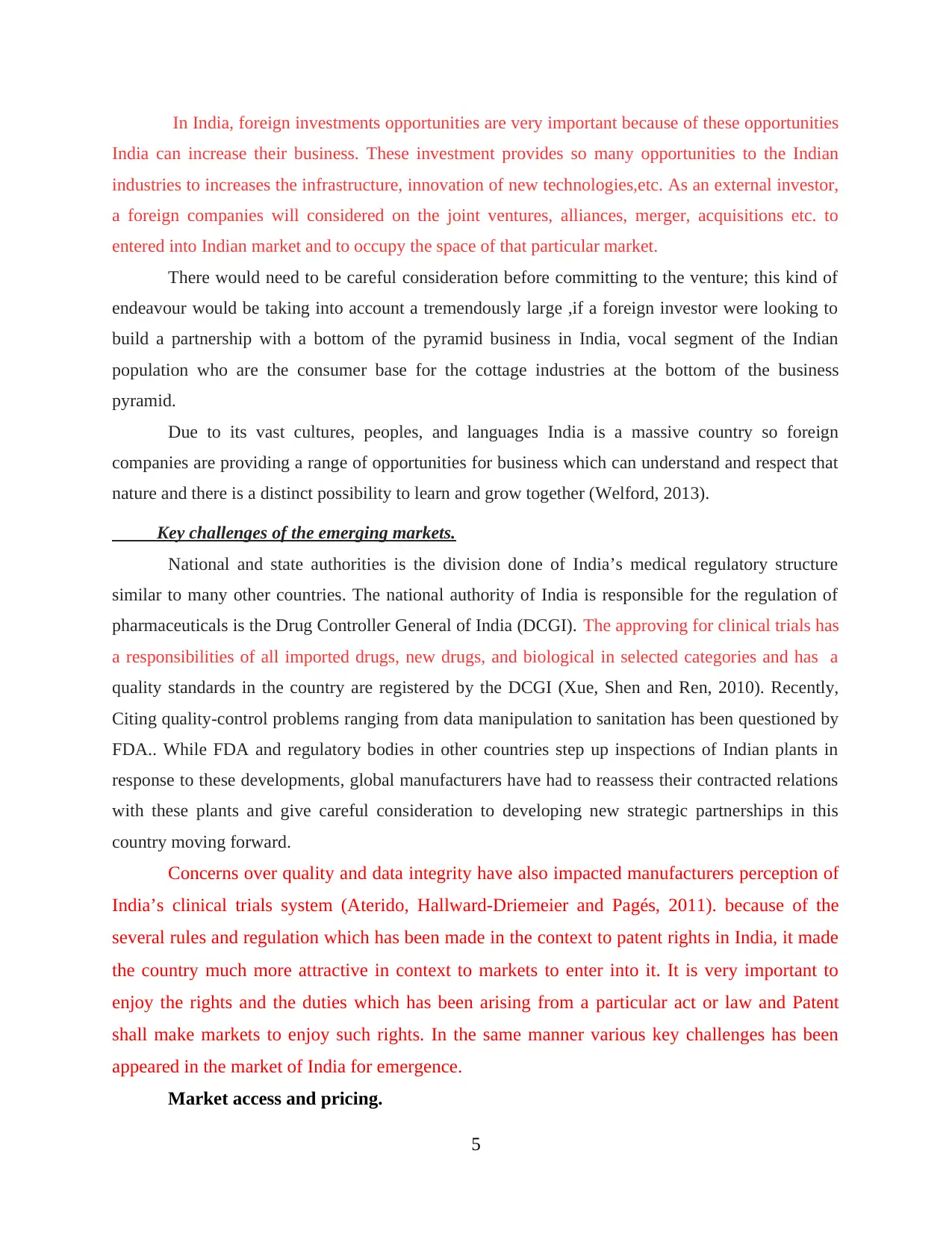
In India, foreign investments opportunities are very important because of these opportunities
India can increase their business. These investment provides so many opportunities to the Indian
industries to increases the infrastructure, innovation of new technologies,etc. As an external investor,
a foreign companies will considered on the joint ventures, alliances, merger, acquisitions etc. to
entered into Indian market and to occupy the space of that particular market.
There would need to be careful consideration before committing to the venture; this kind of
endeavour would be taking into account a tremendously large ,if a foreign investor were looking to
build a partnership with a bottom of the pyramid business in India, vocal segment of the Indian
population who are the consumer base for the cottage industries at the bottom of the business
pyramid.
Due to its vast cultures, peoples, and languages India is a massive country so foreign
companies are providing a range of opportunities for business which can understand and respect that
nature and there is a distinct possibility to learn and grow together (Welford, 2013).
Key challenges of the emerging markets.
National and state authorities is the division done of India’s medical regulatory structure
similar to many other countries. The national authority of India is responsible for the regulation of
pharmaceuticals is the Drug Controller General of India (DCGI). The approving for clinical trials has
a responsibilities of all imported drugs, new drugs, and biological in selected categories and has a
quality standards in the country are registered by the DCGI (Xue, Shen and Ren, 2010). Recently,
Citing quality-control problems ranging from data manipulation to sanitation has been questioned by
FDA.. While FDA and regulatory bodies in other countries step up inspections of Indian plants in
response to these developments, global manufacturers have had to reassess their contracted relations
with these plants and give careful consideration to developing new strategic partnerships in this
country moving forward.
Concerns over quality and data integrity have also impacted manufacturers perception of
India’s clinical trials system (Aterido, Hallward-Driemeier and Pagés, 2011). because of the
several rules and regulation which has been made in the context to patent rights in India, it made
the country much more attractive in context to markets to enter into it. It is very important to
enjoy the rights and the duties which has been arising from a particular act or law and Patent
shall make markets to enjoy such rights. In the same manner various key challenges has been
appeared in the market of India for emergence.
Market access and pricing.
5
India can increase their business. These investment provides so many opportunities to the Indian
industries to increases the infrastructure, innovation of new technologies,etc. As an external investor,
a foreign companies will considered on the joint ventures, alliances, merger, acquisitions etc. to
entered into Indian market and to occupy the space of that particular market.
There would need to be careful consideration before committing to the venture; this kind of
endeavour would be taking into account a tremendously large ,if a foreign investor were looking to
build a partnership with a bottom of the pyramid business in India, vocal segment of the Indian
population who are the consumer base for the cottage industries at the bottom of the business
pyramid.
Due to its vast cultures, peoples, and languages India is a massive country so foreign
companies are providing a range of opportunities for business which can understand and respect that
nature and there is a distinct possibility to learn and grow together (Welford, 2013).
Key challenges of the emerging markets.
National and state authorities is the division done of India’s medical regulatory structure
similar to many other countries. The national authority of India is responsible for the regulation of
pharmaceuticals is the Drug Controller General of India (DCGI). The approving for clinical trials has
a responsibilities of all imported drugs, new drugs, and biological in selected categories and has a
quality standards in the country are registered by the DCGI (Xue, Shen and Ren, 2010). Recently,
Citing quality-control problems ranging from data manipulation to sanitation has been questioned by
FDA.. While FDA and regulatory bodies in other countries step up inspections of Indian plants in
response to these developments, global manufacturers have had to reassess their contracted relations
with these plants and give careful consideration to developing new strategic partnerships in this
country moving forward.
Concerns over quality and data integrity have also impacted manufacturers perception of
India’s clinical trials system (Aterido, Hallward-Driemeier and Pagés, 2011). because of the
several rules and regulation which has been made in the context to patent rights in India, it made
the country much more attractive in context to markets to enter into it. It is very important to
enjoy the rights and the duties which has been arising from a particular act or law and Patent
shall make markets to enjoy such rights. In the same manner various key challenges has been
appeared in the market of India for emergence.
Market access and pricing.
5
Paraphrase This Document
Need a fresh take? Get an instant paraphrase of this document with our AI Paraphraser
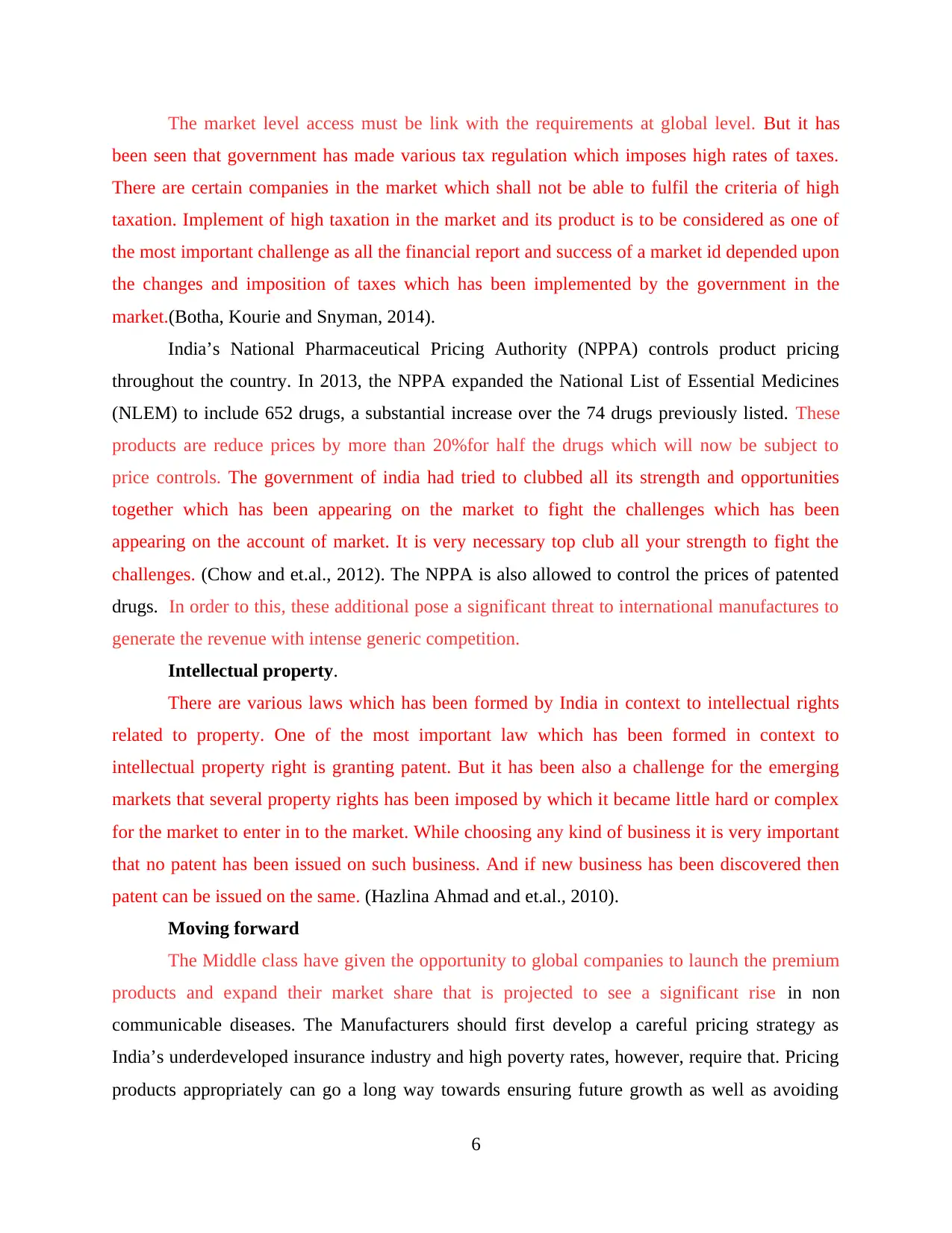
The market level access must be link with the requirements at global level. But it has
been seen that government has made various tax regulation which imposes high rates of taxes.
There are certain companies in the market which shall not be able to fulfil the criteria of high
taxation. Implement of high taxation in the market and its product is to be considered as one of
the most important challenge as all the financial report and success of a market id depended upon
the changes and imposition of taxes which has been implemented by the government in the
market.(Botha, Kourie and Snyman, 2014).
India’s National Pharmaceutical Pricing Authority (NPPA) controls product pricing
throughout the country. In 2013, the NPPA expanded the National List of Essential Medicines
(NLEM) to include 652 drugs, a substantial increase over the 74 drugs previously listed. These
products are reduce prices by more than 20%for half the drugs which will now be subject to
price controls. The government of india had tried to clubbed all its strength and opportunities
together which has been appearing on the market to fight the challenges which has been
appearing on the account of market. It is very necessary top club all your strength to fight the
challenges. (Chow and et.al., 2012). The NPPA is also allowed to control the prices of patented
drugs. In order to this, these additional pose a significant threat to international manufactures to
generate the revenue with intense generic competition.
Intellectual property.
There are various laws which has been formed by India in context to intellectual rights
related to property. One of the most important law which has been formed in context to
intellectual property right is granting patent. But it has been also a challenge for the emerging
markets that several property rights has been imposed by which it became little hard or complex
for the market to enter in to the market. While choosing any kind of business it is very important
that no patent has been issued on such business. And if new business has been discovered then
patent can be issued on the same. (Hazlina Ahmad and et.al., 2010).
Moving forward
The Middle class have given the opportunity to global companies to launch the premium
products and expand their market share that is projected to see a significant rise in non
communicable diseases. The Manufacturers should first develop a careful pricing strategy as
India’s underdeveloped insurance industry and high poverty rates, however, require that. Pricing
products appropriately can go a long way towards ensuring future growth as well as avoiding
6
been seen that government has made various tax regulation which imposes high rates of taxes.
There are certain companies in the market which shall not be able to fulfil the criteria of high
taxation. Implement of high taxation in the market and its product is to be considered as one of
the most important challenge as all the financial report and success of a market id depended upon
the changes and imposition of taxes which has been implemented by the government in the
market.(Botha, Kourie and Snyman, 2014).
India’s National Pharmaceutical Pricing Authority (NPPA) controls product pricing
throughout the country. In 2013, the NPPA expanded the National List of Essential Medicines
(NLEM) to include 652 drugs, a substantial increase over the 74 drugs previously listed. These
products are reduce prices by more than 20%for half the drugs which will now be subject to
price controls. The government of india had tried to clubbed all its strength and opportunities
together which has been appearing on the market to fight the challenges which has been
appearing on the account of market. It is very necessary top club all your strength to fight the
challenges. (Chow and et.al., 2012). The NPPA is also allowed to control the prices of patented
drugs. In order to this, these additional pose a significant threat to international manufactures to
generate the revenue with intense generic competition.
Intellectual property.
There are various laws which has been formed by India in context to intellectual rights
related to property. One of the most important law which has been formed in context to
intellectual property right is granting patent. But it has been also a challenge for the emerging
markets that several property rights has been imposed by which it became little hard or complex
for the market to enter in to the market. While choosing any kind of business it is very important
that no patent has been issued on such business. And if new business has been discovered then
patent can be issued on the same. (Hazlina Ahmad and et.al., 2010).
Moving forward
The Middle class have given the opportunity to global companies to launch the premium
products and expand their market share that is projected to see a significant rise in non
communicable diseases. The Manufacturers should first develop a careful pricing strategy as
India’s underdeveloped insurance industry and high poverty rates, however, require that. Pricing
products appropriately can go a long way towards ensuring future growth as well as avoiding
6
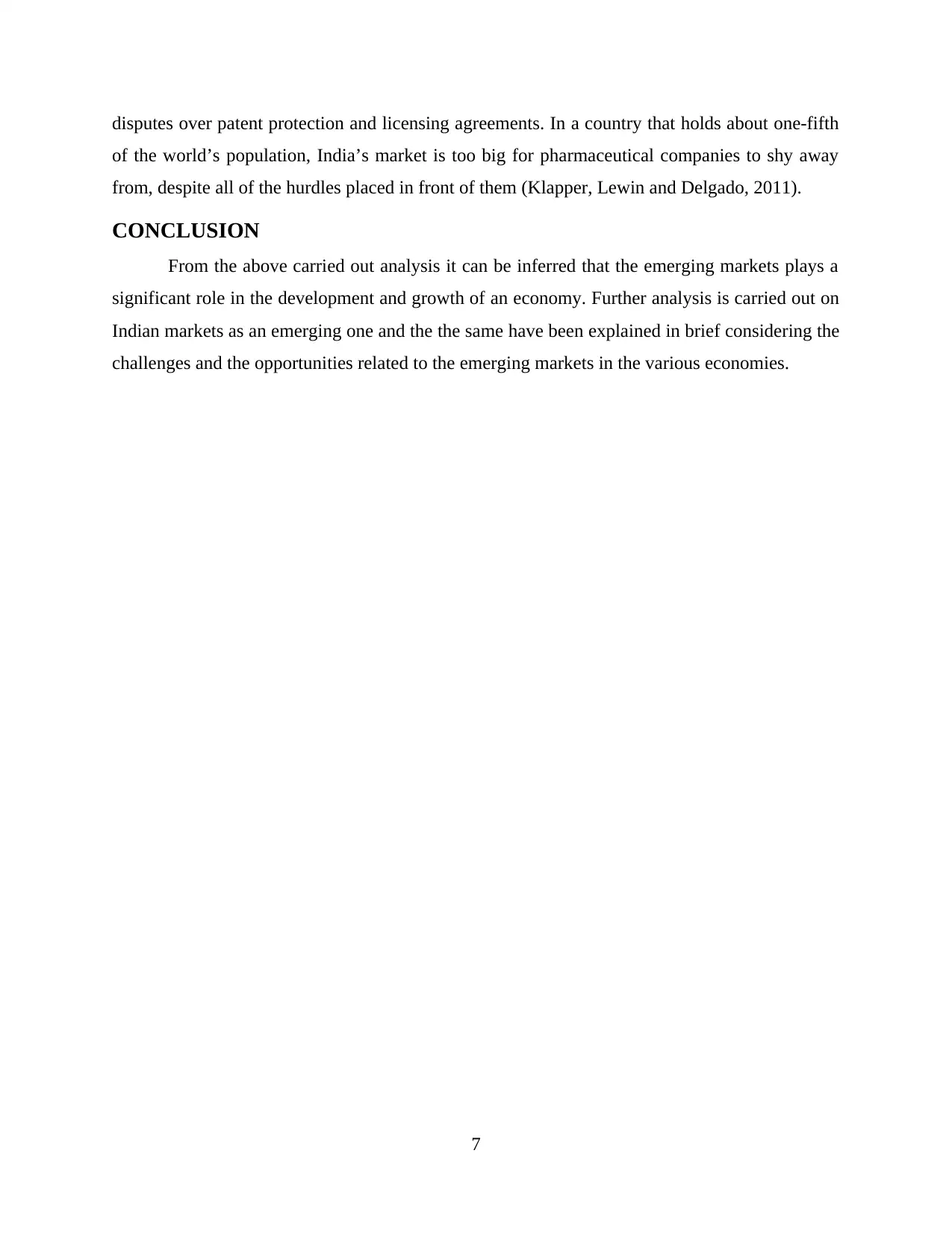
disputes over patent protection and licensing agreements. In a country that holds about one-fifth
of the world’s population, India’s market is too big for pharmaceutical companies to shy away
from, despite all of the hurdles placed in front of them (Klapper, Lewin and Delgado, 2011).
CONCLUSION
From the above carried out analysis it can be inferred that the emerging markets plays a
significant role in the development and growth of an economy. Further analysis is carried out on
Indian markets as an emerging one and the the same have been explained in brief considering the
challenges and the opportunities related to the emerging markets in the various economies.
7
of the world’s population, India’s market is too big for pharmaceutical companies to shy away
from, despite all of the hurdles placed in front of them (Klapper, Lewin and Delgado, 2011).
CONCLUSION
From the above carried out analysis it can be inferred that the emerging markets plays a
significant role in the development and growth of an economy. Further analysis is carried out on
Indian markets as an emerging one and the the same have been explained in brief considering the
challenges and the opportunities related to the emerging markets in the various economies.
7
⊘ This is a preview!⊘
Do you want full access?
Subscribe today to unlock all pages.

Trusted by 1+ million students worldwide
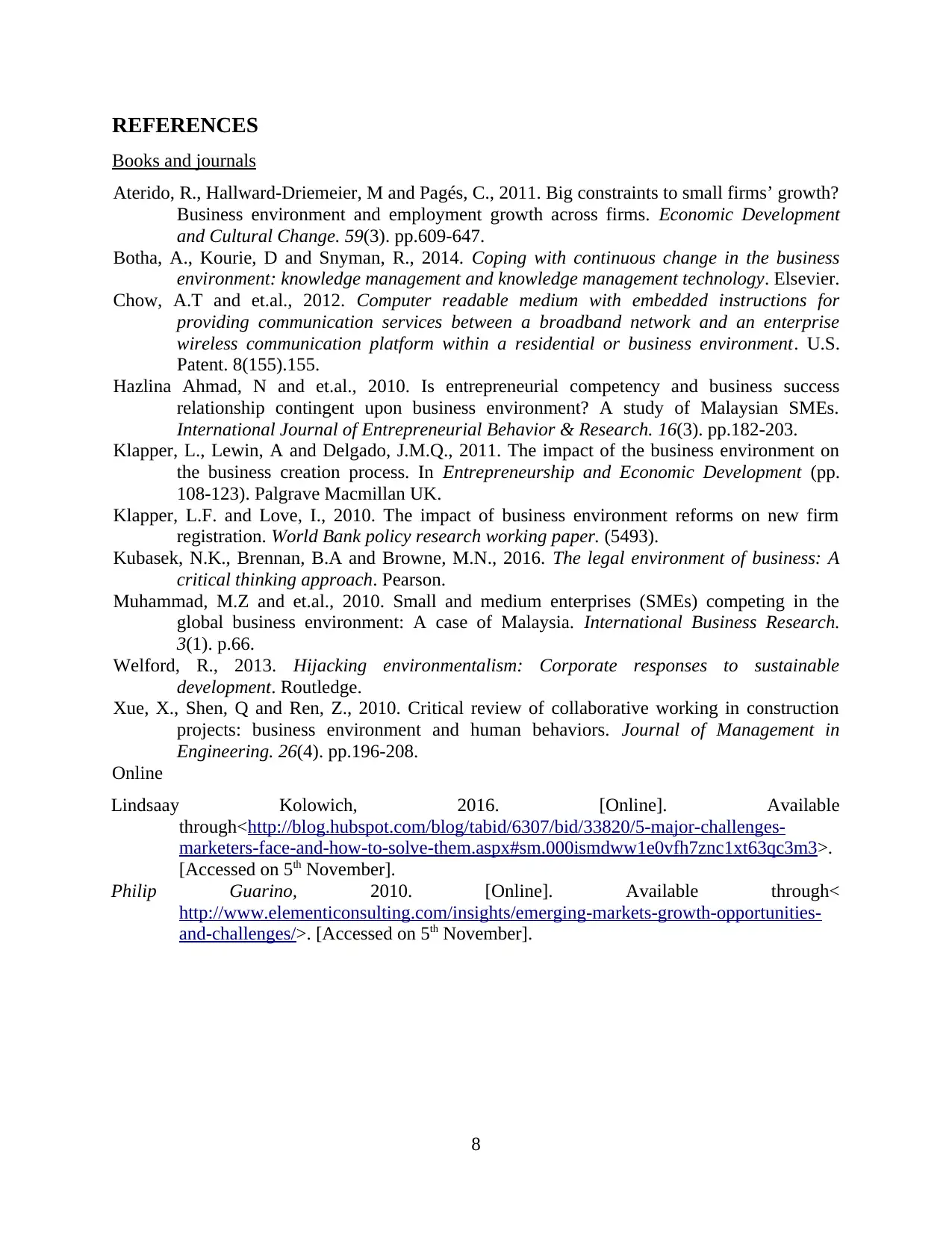
REFERENCES
Books and journals
Aterido, R., Hallward-Driemeier, M and Pagés, C., 2011. Big constraints to small firms’ growth?
Business environment and employment growth across firms. Economic Development
and Cultural Change. 59(3). pp.609-647.
Botha, A., Kourie, D and Snyman, R., 2014. Coping with continuous change in the business
environment: knowledge management and knowledge management technology. Elsevier.
Chow, A.T and et.al., 2012. Computer readable medium with embedded instructions for
providing communication services between a broadband network and an enterprise
wireless communication platform within a residential or business environment. U.S.
Patent. 8(155).155.
Hazlina Ahmad, N and et.al., 2010. Is entrepreneurial competency and business success
relationship contingent upon business environment? A study of Malaysian SMEs.
International Journal of Entrepreneurial Behavior & Research. 16(3). pp.182-203.
Klapper, L., Lewin, A and Delgado, J.M.Q., 2011. The impact of the business environment on
the business creation process. In Entrepreneurship and Economic Development (pp.
108-123). Palgrave Macmillan UK.
Klapper, L.F. and Love, I., 2010. The impact of business environment reforms on new firm
registration. World Bank policy research working paper. (5493).
Kubasek, N.K., Brennan, B.A and Browne, M.N., 2016. The legal environment of business: A
critical thinking approach. Pearson.
Muhammad, M.Z and et.al., 2010. Small and medium enterprises (SMEs) competing in the
global business environment: A case of Malaysia. International Business Research.
3(1). p.66.
Welford, R., 2013. Hijacking environmentalism: Corporate responses to sustainable
development. Routledge.
Xue, X., Shen, Q and Ren, Z., 2010. Critical review of collaborative working in construction
projects: business environment and human behaviors. Journal of Management in
Engineering. 26(4). pp.196-208.
Online
Lindsaay Kolowich, 2016. [Online]. Available
through<http://blog.hubspot.com/blog/tabid/6307/bid/33820/5-major-challenges-
marketers-face-and-how-to-solve-them.aspx#sm.000ismdww1e0vfh7znc1xt63qc3m3>.
[Accessed on 5th November].
Philip Guarino, 2010. [Online]. Available through<
http://www.elementiconsulting.com/insights/emerging-markets-growth-opportunities-
and-challenges/>. [Accessed on 5th November].
8
Books and journals
Aterido, R., Hallward-Driemeier, M and Pagés, C., 2011. Big constraints to small firms’ growth?
Business environment and employment growth across firms. Economic Development
and Cultural Change. 59(3). pp.609-647.
Botha, A., Kourie, D and Snyman, R., 2014. Coping with continuous change in the business
environment: knowledge management and knowledge management technology. Elsevier.
Chow, A.T and et.al., 2012. Computer readable medium with embedded instructions for
providing communication services between a broadband network and an enterprise
wireless communication platform within a residential or business environment. U.S.
Patent. 8(155).155.
Hazlina Ahmad, N and et.al., 2010. Is entrepreneurial competency and business success
relationship contingent upon business environment? A study of Malaysian SMEs.
International Journal of Entrepreneurial Behavior & Research. 16(3). pp.182-203.
Klapper, L., Lewin, A and Delgado, J.M.Q., 2011. The impact of the business environment on
the business creation process. In Entrepreneurship and Economic Development (pp.
108-123). Palgrave Macmillan UK.
Klapper, L.F. and Love, I., 2010. The impact of business environment reforms on new firm
registration. World Bank policy research working paper. (5493).
Kubasek, N.K., Brennan, B.A and Browne, M.N., 2016. The legal environment of business: A
critical thinking approach. Pearson.
Muhammad, M.Z and et.al., 2010. Small and medium enterprises (SMEs) competing in the
global business environment: A case of Malaysia. International Business Research.
3(1). p.66.
Welford, R., 2013. Hijacking environmentalism: Corporate responses to sustainable
development. Routledge.
Xue, X., Shen, Q and Ren, Z., 2010. Critical review of collaborative working in construction
projects: business environment and human behaviors. Journal of Management in
Engineering. 26(4). pp.196-208.
Online
Lindsaay Kolowich, 2016. [Online]. Available
through<http://blog.hubspot.com/blog/tabid/6307/bid/33820/5-major-challenges-
marketers-face-and-how-to-solve-them.aspx#sm.000ismdww1e0vfh7znc1xt63qc3m3>.
[Accessed on 5th November].
Philip Guarino, 2010. [Online]. Available through<
http://www.elementiconsulting.com/insights/emerging-markets-growth-opportunities-
and-challenges/>. [Accessed on 5th November].
8
1 out of 10
Related Documents
Your All-in-One AI-Powered Toolkit for Academic Success.
+13062052269
info@desklib.com
Available 24*7 on WhatsApp / Email
![[object Object]](/_next/static/media/star-bottom.7253800d.svg)
Unlock your academic potential
Copyright © 2020–2025 A2Z Services. All Rights Reserved. Developed and managed by ZUCOL.





